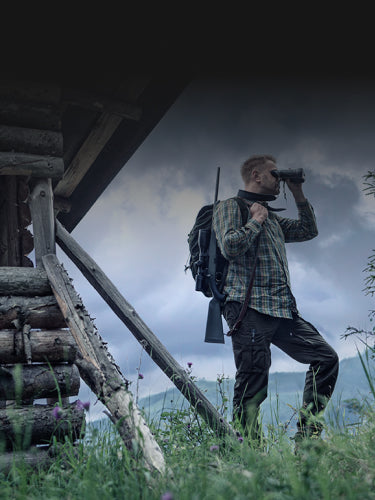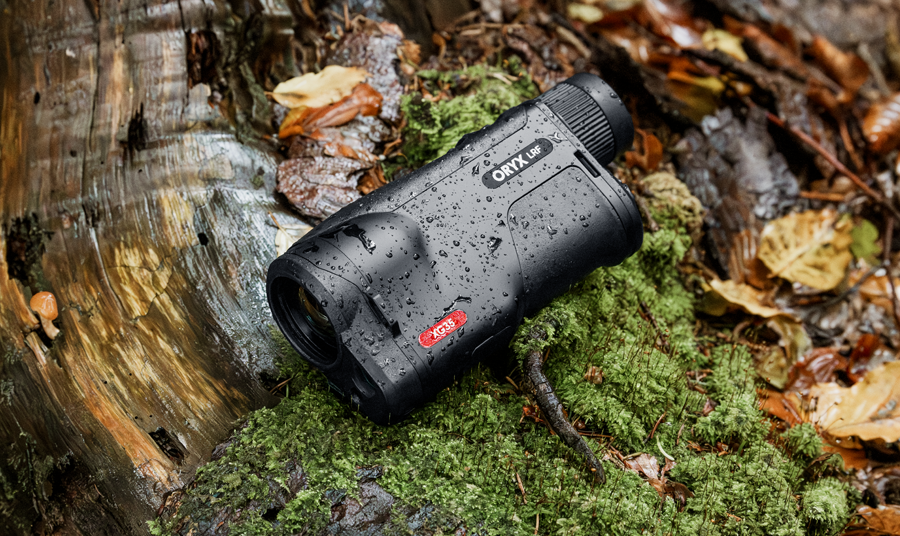If you’re scanning fields for hogs at night, tracking coyotes across rough terrain, or working a search and rescue op in total darkness, you can’t afford to guess your ranges.
You could aim too high and miss clean, or worse, undershoot and wound your target, forcing a long, difficult recovery—if you find it at all. In law enforcement or tactical situations, misjudging distance could delay engagement or put your team in danger. And in search and rescue scenarios, a heat signature that looks “just over that ridge” might actually be half a mile out, costing you precious time and energy chasing ghosts in the dark.
You need to know what you’re seeing, how far away it is, and whether you’re steady enough to take action. Luckily for you, the Pulsar Oryx LRF XG35 is built for people who operate in the real world. If you’ve ever fought your own shaky hands, lost sight of a moving heat signature, or wondered whether your battery would make it through the night, the Oryx is made for you.
Who’s This For?
-
Night hunters who want fast, stable target acquisition without lugging a tripod around.
-
Predator and varmint control professionals scanning multiple fields and tree lines.
-
Search and rescue teams who need a thermal solution that can see and range at a distance right now, not when conditions are perfect.
-
Ranchers, guides, and landowners managing large properties where spotting threats early matters.
-
Tactical operators and law enforcement who need precision and reliability in unpredictable situations.
Thermal Scanning is Hard Without Stability
Holding a monocular steady while tracking a moving target 800 yards away isn’t easy. Even with great thermal resolution, the image can still bounce and blur depending on how shaky the user’s hands are. That’s why most folks either lean on a fence post or carry a tripod… until now.
The Oryx’s electronic image stabilization smooths out hand wobble and reduces motion blur, giving you a clean, watchable image even while moving. Whether you’re glassing on foot, from a UTV, or standing in the back of a pickup, you’ll get clarity when it counts.
Know your Range
How far is that heat signature? 300 yards? 700? With most thermals, you’d have to guess. But guessing leads to missed shots, or worse, unsafe ones.
The built-in laser rangefinder on the Oryx gives you fast, accurate distances out to 1,640 yards. Use it in single-measurement mode or hold it down for continuous scan as your target moves for precise and constant range measurement. It’s one of the few thermals where your eyes and your data stay locked together—no second-guessing required.
No Time for Dead Batteries
There is nothing quite like the frustration of having your batteries die on the piece of equipment you spent thousands of dollars on in the middle of the night. You’re not out there for 30 minutes, you’re out there for hours. The Oryx’s dual battery system ensures that this problem won’t happen to you. With an internal battery and a swappable battery pack combined, you can get up to 12 hours of operation. That’s through dusk, night, and even into sunrise. And when it’s time to swap, you don’t need to reboot the unit; simply slide in a fresh pack and keep going.
Long-Range Eyes Without the Bulk
The 640x480 thermal sensor and 35mm lens give the Oryx a detection range of over 1,900 yards, enough to cover wide fields, ridgelines, or distant timberlines with ease. Yet it stays compact, lightweight, and field-ready with an armored magnesium housing and IP67 waterproofing.
No delicate parts. No fair-weather operation. Just a rock-solid tool that’s ready when you are. When you’re operating in total darkness, your thermal monocular needs stability, range, battery life, and precision. The Pulsar Oryx LRF XG35 has everything you need to solve real-world problems with confidence and clarity.
Frequently Asked Questions
Who is the Pulsar Oryx LRF XG35 designed for?
The Pulsar Oryx LRF XG35 is designed for night hunters, predator control professionals, search and rescue teams, ranchers, guides, landowners, and tactical operators/law enforcement.
Why is stability important in thermal scanning?
Stability is important in thermal scanning because it ensures a clear and watchable image, especially when tracking moving targets at a distance.
How does the Oryx Thermal Monocular help with range estimation?
The Oryx Thermal Monocular features a built-in laser rangefinder that provides fast and accurate distance measurements up to 1,640 yards.
How does the Oryx prevent dead batteries from ruining a mission?
The Oryx is designed to prevent dead batteries by ensuring reliable power supply throughout your operation, eliminating the frustration of equipment failure in critical moments.
What makes the Oryx stand out from other thermal monoculars?
The Oryx stands out with its electronic image stabilization, long-range laser rangefinder, and reliable battery performance, making it a top choice for professionals in various fields.





